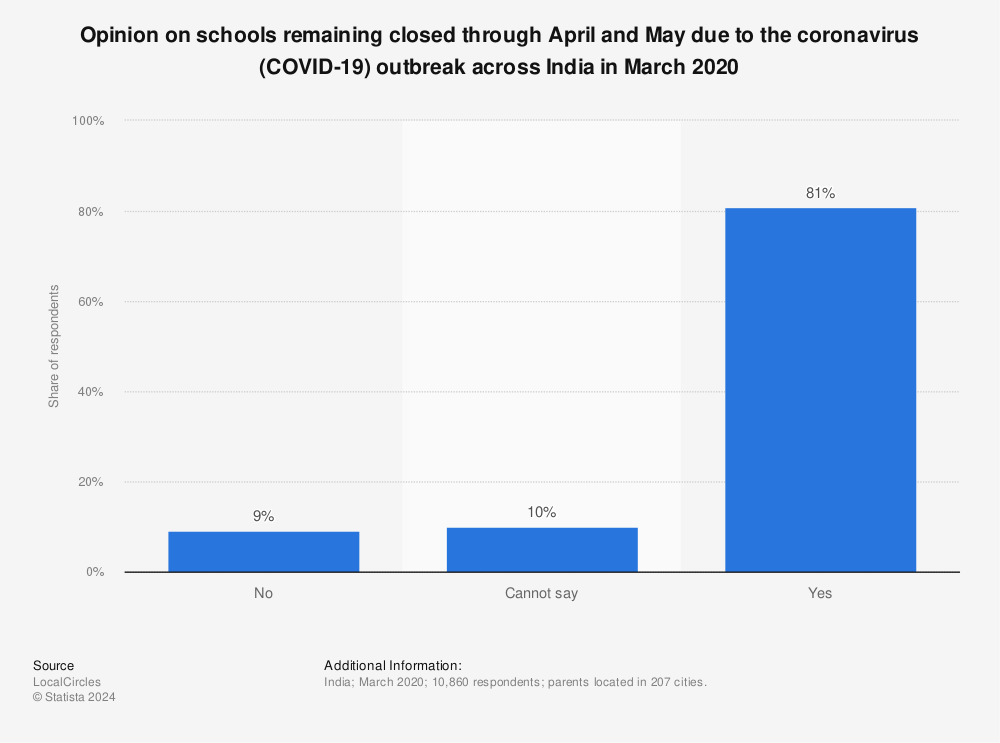The coronavirus pandemic has disrupted several sectors globally, and education is no exception. The education sector has taken a hit with closure of schools, universities, coaching institutes and other educational institutes across the country – affecting students and aspirants preparing for their future. In this situation, online education has become the talk of the town and gaining a lot of traction during the lockdown. Education experts believe that learning should not stop, hence the education has moved from offline to the virtual world.
According to UNESCO monitoring, over 160 countries have implemented nationwide closures, impacting over 87 per cent of world’s student population. India has more than 300 million students in 1.4 million schools and 51,000 colleges, of which learning has been come to the halt after the lockdown.

In this quarantine scenario, students and parents are finding other means to satiate their learning needs. Sonal, a class 7 student, feels a little unproductive as she is not able to go out and do the things she loves. While her school continues to remain shut, she is finding online ways to learn from home.
Similarly, thirty-seven-year-old Poonam Chopra in Delhi is exploring new options for home schooling to keep her 11-year old daughter engaged and help her learn, during the lockdown.

The changes certainly have caused inconvenience, and prolonged closures of schools and colleges are significantly affecting the education calendar. But this has also prompted new technology innovations over the past few weeks – where the education industry is giving a serious thought to making the courses online.
“The online classes have become a great saviour for higher education in India during the present Covid-19 pandemic and have paved the way for a more effective integration of online and offline teaching learning environment that the UGC and MHRD has been trying to create for some time,” says Prof. PB Sharma, vice chancellor of Amity University, Gurugram. “The online classes are also providing a great learning experience both for the students and the faculty.”
He further adds that Amity University Gurugram has also asked its faculty to record as many classes as possible and create and upload online e-resources for further use by students.
Along with Amity University, many other institutes such as Indian Institute of Management (IIM) Ahmedabad deferred its annual convocation which was scheduled for March 21. IIM-Bangalore has taken a similar decision.
Universities and colleges are also using online video streaming solutions such as Microsoft Teams, Microsoft LMS, Zoom Meetings to offer such classes. Schools are also providing live academic sessions to ensure un-interrupted learning by leveraging online tools present in the market.
Dr. Roopa Marwaha Bhalla, principal at Gurugram-based RPS International School shares, “The only medium of conducting classes in this lockdown situation is the ‘live lecture’. We hope at least 60 per cent of the students start taking advantage of it. If parents take it seriously, we can make it 100 per cent successful. This transition from offline to online learning will help schools to a great extent.”
Similarly, other schools such as Shemford Group of Futuristic Schools are also providing home-learning solutions, live classes, flipped-learning, so that the students can access content taught by the teacher at home. This also helps the students to access audio-visual explanation of concepts, solved examples, e-books, interactive simulations, practice questions, adaptive assessments and more at their own convenience.
Since staying at home is the best that we can do now, education technology companies are taking online education to the next level with industry players facilitating remote learning – connecting students and teachers to ensure a seamless transition from offline to online education systems.
Education tech players like Byju’s, Simplilearn, UpGrad, Brainly, Next Education, Unacademy, Coursera, Catalyst are offering online lessons to ensure that even if students miss school, they don’t miss out on their daily lessons. The solutions provided by these platforms allow students to join live classes from anywhere and revisit the recorded sessions as many times as they want; and at the same time allowing schools to take live classes with added benefits of creating a virtual and interactive classroom.
Beas Dev Ralhan, CEO and co-founder, Next Education Pvt Ltd, a K-12 solutions provider, states, “Indian education sphere is gradually embracing the idea of online classes as it is the best possible solution in a crisis like this. If aided with a mobile, computer or laptop and a basic internet connection, students can attend classes from wherever they are.”

Find more statistics at Statista
Ed-tech players on cloud nine
Though the outlook for majority sectors remain negative, few segments will remain unscathed – and ‘ed-tech’ is one of them. Projections show that the e-learning market worldwide is forecast to surpass US$ 243 billion by 2022. It clearly states that e-learning has become a global trend, and more and more people are preferring it over traditional classes.
Having said that, ed-tech companies are better off as they can continue to offer their services and charge for the same from students with availability of teachers on call.
Making most out of the lockdown, students and professionals are signing up for online classes; or entrance exams like the JEE, NEEET, UPSC, SSC; or upskilling. As a result, a clutch of ed-tech players such as UpGrad, Catalyst, Brainly, Simplilearn among others have seen a sharp rise in new users and traction.
In March, Simplilearn saw 15 per cent jump in users enrolling for courses on cyber security, cloud, DevOps, AI (artificial intelligence) and data science. Similarly, Catalyst Group, online learning platform, has witnessed 30-40 per cent rise in admissions.

Catalyst CEO and founder Akhand Swaroop Pandit tells SME Futures, “Overall, we have witnessed 30-40 per cent in admissions in the last two to three days and also the number of students regularly attending the online classes are increasing due to colleges and school shutdown. Daily watch minutes are almost doubled in the past two to three days as students are at home and attending regular classes.”
It is interesting to note that with colleges and institutes going online, the attendance of students has also remarkably improved. For instance, at Amity University, which already has online infrastructure for years, the online classes are witnessing full attendance.
“As per the online reports being received from various institutions in Amity University Gurugram, the attendance of students in online classes is almost 90-95 per cent. The timely conduct of online classes as per schedule is automatically recorded, and thus, leaves no room for alteration later on,” Prof. Sharma informs.
Govt’s digital learning platforms see surge too
Surprisingly, not just private players are enjoying their moment, but the government digital platforms such as SWAYAM and digital online library are also experiencing great amount of digital footfall.
As per the data, the access to the national online education platform SWAYAM and other digital initiatives has tripled in the last one week since lockdown. About 50,000 people have accessed SWAYAM since March 23, 2020. This is over and above the 25 lakh students/learners, who are already enrolled in the 571 courses of the January 2020 semester of SWAYAM.
Audience in video category has also increased. Videos of the SWAYAM Prabha DTH TV channels are viewed by around 50,000 people every day. While, the National Digital Library is now being accessed by about 43,000 people daily – which is more than double of the usual number of persons accessing it, according to the HRD ministry.

The platform is currently giving free access to teaching-learning resources as earlier the access was time-bound and needed registration in advance.
A repository of 1900 courses under SWAYAM is being accessed by people from over 60 countries. The significant majority is from India and the other countries include USA, UAE, Germany, Nepal, Singapore, Canada, United Kingdom and Australia.
On the other hand, education portals of NCERT like Diksha, ePathshala, NROER and NIOS and the other ICT initiatives like robotics education (e-Yantra), open source software for education (FOSSEE), virtual experiments (virtual labs) and learning programming (spoken tutorial) are also experiencing very large access rates.
Coronavirus to have a lasting impact on education system
Although it is too early to judge how the current trend due to the COVID-19 outbreak will affect the education system across the country, but experts are suggesting that it could have a lasting impact on the trajectory of learning innovation and digitization.
The current situation has made businesses rethink their strategies. In the past few weeks, there is an increase in partnerships within government, digital platforms, publishers, education professionals and network operators. Public private partnerships are getting importance. Most schools, colleges and universities in India are strengthening their infrastructure with collaboration with technology providers.
Considering the current situation, the ed-tech platforms are coming up with new solutions and schemes. They are even giving free access to attract more and more people on their platforms. For instance, Catalyst is giving free access to students for various online classes on competitive exams. Similarly, Next Education has launched new solutions and free subscription schemes.
Ralhan of Next Education talks about the ‘School-in-a-box’ platform, which makes schools run virtually using tools such as NextERP, NextLMS, offer live lectures and online classes and more. TeachNext@Home is another solution that allows students to clarify doubts, revise concepts, and reinforce their learning, anytime anywhere.
“Through Next Learning Platform, our mission is to enable schools to take a step forward in the right direction so that their academic operations are not hampered amid the COVID-19 outbreak,” he adds.
Though there is a significant migration towards online, there is still a digital divide – that can’t be ignored. This lockdown can impact those who are less affluent and are not digital savvy. Those students are totally cut out from the educational curriculum.
According to a survey conducted to know the impact of lockdown on learning and education by an online learning community Brainly, only 36 per cent of the total respondents (students) under lockdown are receiving online education. The survey also found that although 26 per cent of the respondents are excited to spend this time with friends and family, almost 34 per cent of the students are bored at home during this break.
The Indian education sector is still behind in technology adoption and is undergoing digital transformation, the survey indicates.
Commenting on the situation, Michał Borkowski, co-founder and CEO, Brainly says, “While numerous schools in the country have tied up with ed-tech platforms to offer online learning to students, our survey findings indicate that a major chunk of them have not made such associations yet. We expect more schools and teachers to follow this path however and introduce online learning in the coming days. Students and parents seeking assistance for their academic queries are turning to online learning platforms, such as Brainly, where they can get help with learning already.”
All won’t be hunky-dory
Despite the positive outcomes, there are certain areas where the education sector will see some hiccups. Entities, where there are some delays on fee collection from students, are likely to get impacted and they might face challenges in meeting their staff expenses and debt servicing.
Receipt of different aids under government schemes and reimbursements can be delayed as the Centre and state government’s focus have shifted to controlling pandemic.
“Hence, managing the finances and working capital requirement during this period will be crucial for these institutions,” says CARE Ratings research. “In case the lockdown continues for long period, the cash inflows of these entities are likely to get deferred which can put pressure on the finances of these entities in the short term. However, higher educational institutions where the admissions take place late in June-September period may not get affected during this period.”
Coaching centres and vocational training providers across India may have tough times if the pandemic continues for a long time.
“It can impact their financial position as any delay in conducting of various entrance exams will defer commencement of their academic sessions and ultimately their cash flows,” the agency adds.










